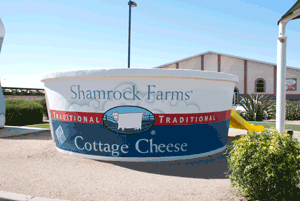Every October, Shamrock Farms, located in Stanfield, Ariz., opens up its modern 10,000-cow dairy to the public, taking advantage of the growing agricultural disconnect as a way to market its brand and teach Arizona's children about large-scale dairying.
 "After arriving at Shamrock Farms, children are "tagged" with a bracelet and become part of the herd," noted Frank Boyce, Shamrock Farms' manager. Children then pile on the black and white cow spotted tram to begin the interactive tour of the dairy.
"After arriving at Shamrock Farms, children are "tagged" with a bracelet and become part of the herd," noted Frank Boyce, Shamrock Farms' manager. Children then pile on the black and white cow spotted tram to begin the interactive tour of the dairy.
The first stop is the feeding area where the food pyramids for the cow and the human are side by side. Tour guides enhance the experience by comparing the requirements in the human and dairy cow diets. They also explain the importance of a well-balanced diet to ensuring cow health and quality milk production.
They spend 10 to 15 minutes on a playground made of a giant milk bottle and cottage cheese container before going into the milk barn where they can watch 200 cows being milked at once. They are also shown an eight-minute video about how Shamrock Farms milk is processed.
 Kids are then taken to the calf zone. According to Romy Boyce, a Shamrock Farms' tour guide, this area is a favorite for the children. In the calf zone, students have the chance to pet calves and pick out their favorite. Once their calf is chosen they can name and "adopt" her.
Kids are then taken to the calf zone. According to Romy Boyce, a Shamrock Farms' tour guide, this area is a favorite for the children. In the calf zone, students have the chance to pet calves and pick out their favorite. Once their calf is chosen they can name and "adopt" her.
Students then go to the Desert Oasis-The Home of the Stars Saudi-style shade pens where the milk cows live. Here the students are taught about how cows like Roxie, the Shamrock Farms' spokescow, are pampered and cared for.
The tour concludes with the interactive session in the welcome center where students view a detailed event timeline of the world, U.S., and Shamrock's dairy history. They are also given some past and present facts, comparing Shamrock Farms in 1922 to 2010.
"The main thing we hope to get across to the children is that the animals are safe and well cared for on this family-owned dairy," noted Romy. "We want children to walk away and say wow . . . I learned so much."
 "After arriving at Shamrock Farms, children are "tagged" with a bracelet and become part of the herd," noted Frank Boyce, Shamrock Farms' manager. Children then pile on the black and white cow spotted tram to begin the interactive tour of the dairy.
"After arriving at Shamrock Farms, children are "tagged" with a bracelet and become part of the herd," noted Frank Boyce, Shamrock Farms' manager. Children then pile on the black and white cow spotted tram to begin the interactive tour of the dairy. The first stop is the feeding area where the food pyramids for the cow and the human are side by side. Tour guides enhance the experience by comparing the requirements in the human and dairy cow diets. They also explain the importance of a well-balanced diet to ensuring cow health and quality milk production.
They spend 10 to 15 minutes on a playground made of a giant milk bottle and cottage cheese container before going into the milk barn where they can watch 200 cows being milked at once. They are also shown an eight-minute video about how Shamrock Farms milk is processed.
 Kids are then taken to the calf zone. According to Romy Boyce, a Shamrock Farms' tour guide, this area is a favorite for the children. In the calf zone, students have the chance to pet calves and pick out their favorite. Once their calf is chosen they can name and "adopt" her.
Kids are then taken to the calf zone. According to Romy Boyce, a Shamrock Farms' tour guide, this area is a favorite for the children. In the calf zone, students have the chance to pet calves and pick out their favorite. Once their calf is chosen they can name and "adopt" her. Students then go to the Desert Oasis-The Home of the Stars Saudi-style shade pens where the milk cows live. Here the students are taught about how cows like Roxie, the Shamrock Farms' spokescow, are pampered and cared for.
The tour concludes with the interactive session in the welcome center where students view a detailed event timeline of the world, U.S., and Shamrock's dairy history. They are also given some past and present facts, comparing Shamrock Farms in 1922 to 2010.
"The main thing we hope to get across to the children is that the animals are safe and well cared for on this family-owned dairy," noted Romy. "We want children to walk away and say wow . . . I learned so much."









